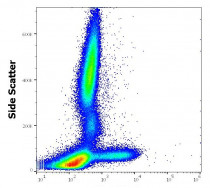ARG54231
anti-CD160 antibody [BY55] (PE)
anti-CD160 antibody [BY55] (PE) for Flow cytometry and Human
Immune System antibody
Overview
| Product Description | PE-conjugated Mouse Monoclonal antibody [BY55] recognizes CD160 |
|---|---|
| Tested Reactivity | Hu |
| Tested Application | FACS |
| Specificity | The clone BY55 recognizes CD160, a 27 kDa glycoprotein expressed on NK cells, NK-T cells, intestinal intraepithelial lymphocytes, TCR-gamma/delta T cells and a small population of TCR-alpha/beta T cells. detects both GPI-anchored and transmembrane form of CD160. |
| Host | Mouse |
| Clonality | Monoclonal |
| Clone | BY55 |
| Isotype | IgM |
| Target Name | CD160 |
| Antigen Species | Human |
| Immunogen | Human NK cell line YT2C2 |
| Conjugation | PE |
| Alternate Names | BY55; Natural killer cell receptor BY55; NK28; NK1; CD antigen CD160; CD160 antigen |
Application Instructions
| Application Suggestion |
|
||||
|---|---|---|---|---|---|
| Application Note | * The dilutions indicate recommended starting dilutions and the optimal dilutions or concentrations should be determined by the scientist. |
Properties
| Form | Liquid |
|---|---|
| Purification Note | The purified antibody is conjugated with R-Phycoerythrin (PE) under optimum conditions. The conjugate is purified by size-exclusion chromatography and adjusted for direct use. No reconstitution is necessary. |
| Buffer | TBS, 15 mM Sodium azide and 0.2% (w/v) high-grade protease free BSA |
| Preservative | 15 mM Sodium azide |
| Stabilizer | 0.2% (w/v) high-grade protease free BSA |
| Storage Instruction | Aliquot and store in the dark at 2-8°C. Keep protected from prolonged exposure to light. Avoid repeated freeze/thaw cycles. Suggest spin the vial prior to opening. The antibody solution should be gently mixed before use. |
| Note | For laboratory research only, not for drug, diagnostic or other use. |
Bioinformation
| Database Links | |
|---|---|
| Gene Symbol | CD160 |
| Gene Full Name | CD160 molecule |
| Background | CD160 is a cell surface glycoprotein of immunoglobulin superfamily, which functions as a costimulatory receptor expressed mainly on cytotoxic cell populations and recognizing both classical and non-classical MHC class I molecules. It can form disulfide-linked multimers. Down-modulation of CD160 occurs as a consequence of its proteolytic cleavage and the released soluble form was found to impair the MHC-class I specific cytotoxicity of CD8+ T lymphocytes and NK cells. In contrast to GPI-anchored isoform with broader expression among CD160 positive cells, expression of the transmembrane isoform is restricted to NK cells and is activation-dependent. |
| Function | Receptor showing broad specificity for both classical and non-classical MHC class I molecules. [UniProt] |
| Research Area | Immune System antibody |
| Calculated MW | 20 kDa |
Images (3) Click the Picture to Zoom In
-
ARG54231 anti-CD160 antibody [BY55] (PE) FACS image
Flow Cytometry: Human peripheral whole blood stained with ARG54231 anti-CD160 antibody [BY55] (PE) (10 µl reagent / 100 µl of peripheral whole blood).
-
ARG54231 anti-CD160 antibody [BY55] (PE) FACS image
Flow Cytometry: Human lymphocytes stained with ARG54231 anti-CD160 antibody [BY55] (PE) (10 µl reagent / 100 µl of peripheral whole blood) and ARG53782 anti-CD19 antibody [LT19] (APC) (10 µl reagent / 100 µl of peripheral whole blood).
-
ARG54231 anti-CD160 antibody [BY55] (PE) FACS image
Flow Cytometry: Separation of human CD160 positive B cells (red-filled) from neutrophil granulocytes (black-dashed). Human peripheral whole blood stained with ARG54231 anti-CD160 antibody [BY55] (PE) (10 µl reagent / 100 µl of peripheral whole blood).










